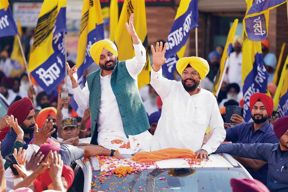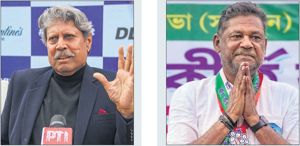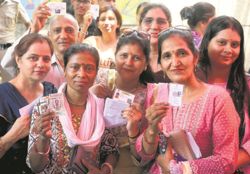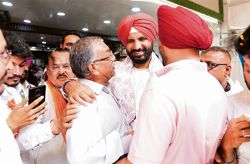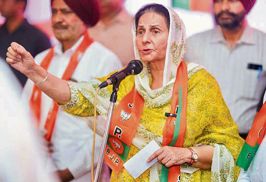
Electoral process underway: New York City, financial capital of the US, has always had importance as the first port of entry for immigrants to America. Reuters
Luv Puri
Journalist and Author
In one of the first signs of post-Covid-19 normalcy in a city which became the symbol of mayhem caused by the pandemic last year, a fierce campaign was the highlight of the primary elections for the Mayor of New York City, a coveted position which provides arguably one of the most visible faces after the US President. The primary elections are also taking place for the city council, public advocate and comptroller.
Election for the Democratic and Republican primaries was on June 22 and the General Elections will take place on November 2. The General Elections will be a formality as the winner of the Democratic primary will be the next Mayor. This is because the city is heavily Democratic with 3.6 million registered Democrats with only 0.5 million Republicans. The stakes are high as the new administration of the city will oversee the revitalisation after a year of immense loss, both in terms of human and financial loss. The city, financial capital of the US, has always acquired an outsized importance in the global context as it is the first port of entry for millions of immigrants to the US. New York City also has one of the largest concentrations of Indian-Americans in the US.
Among the top contenders for the Mayor’s position are a former police officer and African-American Eric Adams, followed by seven other candidates, including Maya Wiley, a former counsel to Mayor Bill de Blasio. A new system — which has triggered a lot of interest — is in place that allows voters to rank up to five candidates in order of preference. The idea is to have a candidate who appeals to all sections of the population. Early trends indicate that for the Mayor’s position, Eric Adams leads the tally. The primary elections for members of the NYC council saw unprecedented ten Indian-American candidates in the running. In the counting, which is still going on, three of these candidates are in close contention for representing their respective districts.
In the big picture analysis, NYC is no exception to issues of other big global cities where turf wars are common between the state and city administrations. One of the continuing issues of contention is the contested jurisdiction of domains pertaining to the city between Albany, New York state’s capital, and New York City, comprising the five boroughs. Even when Covid-19 was ravaging the city, there were frequent public feuds between NYC Mayor Bill de Blasio and New York State Governor Andrew Cuomo on issues such as the timing of the lockdown and opening of schools.
In terms of electability, due to the sheer diversity of the city and the new ranking system, a candidate has to reach out to diverse constituencies. Broadly speaking, African-Americans comprise 24.3 per cent of the electorate whereas Hispanic or Spanish speakers are 29.1 per cent. Asians are around 14 per cent. The Whites, a general term for people with European origin, are around 42 per cent. They include Jews who form nearly 14 per cent of the population.
The evolving story of ruling power structures in NYC is also the changing pattern of US immigration as global events ignited fresh waves of movement to the new world. In the early 20th century, the power in the city was wielded by Tammany Hall, an organisation that became a pivotal political machine of the city to put persons in influential political positions of the city. De facto, it became an organisation of Irish Catholics who came to NYC after the infamous Irish famine in the last quarter of the 19th century. With the decline of influence of Tammany Hall, the demographics of other communities swelled.
While the Mayor’s position is important in the city’s history, so have been the unelected bureaucrats. This is elaborated in greater detail by Robert Caro in his magisterial book — The Power Broker — in which he describes how urban planner Robert Moses, from 1920s to 1970s, reshaped the city with infrastructural projects that often benefitted the rich with deleterious effects on the poor. Caro, in his book, exposed how his projects such as public beaches were constructed to keep the poor away.
In the past 40 years, each Mayor has had his fair share of crisis to tackle. Edward Koch became the first Jewish Mayor from 1978 to 1989 and his tenure coincided with NYC becoming the epicentre of the AIDS epidemic. His successor, David Dinkins, who died last year, was the first African-American Mayor and his tenure was tarnished by the infamous Crown Heights riots in 1991 between Hasidic Jews and African-Americans. Dinkins was followed by Rudolph Giuliani who was the Mayor when the 9/11 attacks took place. Though he claimed that under his watch, crime reduced in the city, his detractors point out that incidents of police repression of minorities increased.
Giuliani’s tenure was followed by billionaire Michael Bloomberg under whose watch the tourist industry grew. He banned public smoking indoors and launched a public campaign against diabetes and obesity. His critics point out that his policies made the city more unequal. Mayor Bill de Blasio was elected on the promise of making the city more equitable. The present elections have been dominated by issues linked to public safety (the annual crime rate increased for the first time in the past 30 years), racially based policing and post-Covid-19 recovery plans.
With electoral process for the primaries nearing completion, global attention will be on the prospective policies of the new NYC administration. The pandemic has redefined the work culture. It has left the white collar unscathed, but put a strain on the economically weaker communities and turned a heightened spotlight on public health issues, particularly in dense cities like NYC. Along with this, the new Mayor will have to address the age-old, city-specific issues and concerns, including the rising crime graph.
Join Whatsapp Channel of The Tribune for latest updates.






















